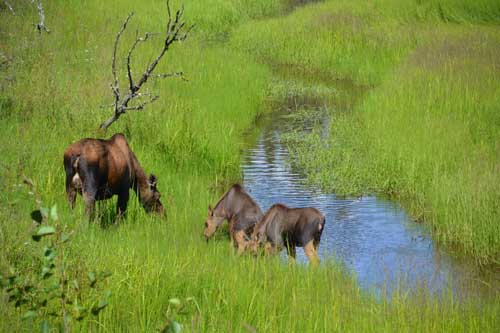The opportunity to see wildlife is a major attraction for many visitors to the North Country. The MILEPOST® highway logs point out spots along the highways where travelers may see Dall sheep, moose, caribou, bear and other mammals. Wildlife and bird viewing areas of particular interest are noted in the text.
Booking agents packaging custom Alaska vacations can include wildlife touring on your trip. Also check with tour desks at motels/hotels or ask your bed-and-breakfast or campground host about wildlife viewing tour operators available locally.
A good resource for wildlife viewing information is the Alaska Dept. of Fish and Game (ADF&G). Check out their list of Alaska wildlife viewing sites at “Where to Go” under the Viewing subhead.
Birding
Alaska has nearly 500 species of birds, so visitors have a good chance of seeing many varieties without even trying. Birding newsletters and statewide bird checklists are available at the Alaska Dept. of Fish and Game’s Wings Over Alaska web site.
St. Paul Island is a birders dream with 248 species of birds. In Alaska’s Pribilof Islands, St. Paul is 300 miles off the coast of Alaska in the heart of the Bering Sea. NOTE: The island also has northern fur seal rookeries.
Enjoy spring and summer birding in Fairbanks at Creamer’s Field Migratory Waterfowl Refuge, in Anchorage at the Anchorage Coastal Wildlife Refuge/Potter Marsh and at festivals that celebrate the incredible migrations that take place in Alaska.
The Copper River Delta Shorebird Festival in Cordova, AK, and the Kachemak Bay Shorebird Festival in Homer, AK, both scheduled for May 4–7, 2017, offer an opportunity to see migrating shorebirds and listen to experts. The Alaska Bald Eagle Festival takes place Nov. 6–11, 2017 in Haines, AK with 1,000–3,000 bald eagles congregating on the Alaska Chilkat Bald Eagle Preserve.
Bear Viewing
There are 3 types of bears in Alaska: polar bears, black bears and brown bears. Viewing Ursus arctos, the brown bear or grizzly, ranks high on visitors’ wish lists of activities during a trip to Alaska. Most private bear viewing businesses offer day trips to see brown bears, although overnight and multi-day trips with lodging or camping are available. The hot spots for bear viewing tours in Southcentral and southwestern Alaska are West Cook Inlet, Kodiak Island and the Alaska Peninsula, where coastal brown bears congregate in large numbers to fish at stream mouths or graze sedge fields.
Access is mainly by small plane, on floats or wheels, out of Homer, Kodiak, Kenai–Soldotna, King Salmon, Anchorage and Seward. Air services offer aerial bear viewing, guided land-based bear viewing tours and round-trip transportation to bear viewing camps and lodges. Tour operators often offer sport fishing, bird watching and other activities along with bear viewing. A few tour operators offer coastal brown bear viewing by boat.
Air service to bear viewing destinations is offered by Natron Air in Soldotna; several charters out of Seward, Homer and Kodiak; and Rust’s Flying Service out of Anchorage (see display ads in Soldotna and Anchorage).
Kodiak National Wildlife Refuge, accessible by air charter or boat, is home to about 3,000 bears. The refuge offers a bear viewing platform at the O’Malley River where visitors can observe bears in the wild. Contact the refuge for details.
On the Alaska Peninsula, bears congregate at Brooks Falls, near Brooks Camp in Katmai National Park, for the red salmon run. Camping is available at the park’s Brooks Camp and lodging is available at Brooks Lodge through the park concessionaire.
The McNeil River State Game Sanctuary, about 100 miles southwest of Anchorage, is a favorite site of photographers and videographers intent on documenting brown bears. Visits to McNeil are by permit only, selected in an annual lottery. Information on permits is available online from Alaska Dept. of Fish and Game.
Off of the Parks Highway, in Talkeetna, several flightseeing services offer bear and wildlife viewing options. And in Fairbanks, at the north end of the Parks Highway, Warbelow’s Air Ventures offers a September flightseeing trip to Kaktovik to see polar bears.
In Southeast Alaska, the U.S. Forest Service manages 5 bear viewing sites: Margaret Creek at Ketchikan (accessible only by boat or floatplane, check with Visit Ketchikan for local guide suggestions); Dog Salmon Creek at Prince of Wales Island; Anan Wildlife Observatory, accessible by boat, located southeast of Wrangell (check for local guide suggestions); Stan Price State Wildlife Sanctuary at Pack Creek, located on Admiralty Island; and Fish Creek Wildlife Observatory near Hyder, where both brown and black bears may be photographed here as they fish for salmon from mid-July to early September.
Wildlife Cruises
Both charter cruises and scheduled day cruises are available to view wildlife along Alaska’s magnificent coastline. Passengers on day cruises have the opportunity to see some of Alaska’s most famous glaciers and also its wildlife like sea otters, Steller sea lions, dolphins, harbor seals, Dall porpoises, whales (minke, gray, fin, humpback), puffins, eagles, black-legged kittiwakes, common murres, cormorants, and parakeet and rhinoceros auklets.
In Southeast Alaska, whale watching, glacier tours and custom sightseeing cruises are arranged by Viking Travel in Petersburg. Day cruises concentrate on whale watching and sightseeing in such gems as Misty Fjords National Monument (out of Ketchikan), Tracy Arm (out of Juneau) and Glacier Bay (also out of Juneau). Juneau’s Adventure Bound Alaska Cruises offers daily trips to Tracy Arm, a long, narrow fjord that extends into the heavily glaciated Coast Mountain Range, 50 miles southeast of Juneau, to see wildlife, waterfalls and glaciers.
Glacier Bay National Park offers wildlife and spectacular glacier scenery. Glacier Bay is on the itinerary of many Inside Passage cruise ships and is on the Alaska Marine Highway ferry system. It is also a popular destination for day cruises out of Juneau. Charter boat tours of Glacier Bay, Icy Strait and Point Adolphus are available in Gustavus, the small community just outside the park boundary. Wildlife cruises may be arranged through local accommodations, such as Annie Mae Lodge and Glacier Bay Lodge.
Full-day, half-day and dinner cruises of Kenai Fjords National Park depart daily from Seward, located 127 miles south from Anchorage. These scheduled cruises explore the park’s glaciated coastline and the substantial populations of marine mammals and birds that make their home there. Full-day cruises also visit Chiswell Islands National Wildlife Refuge. Operators include: Kenai Fjords Tours; Major Marine Tours; and Sunny Cove Sea Kayaking Co. Charter boats are also available out of Seward for wildlife viewing. And while you are in Seward, visit the Alaska SeaLife Center and learn about the birds and marine mammals of coastal Alaska.
Daily scheduled cruise tours and custom sightseeing cruises of Prince William Sound’s glaciers and wildlife depart from Whittier and Valdez. Tour operators include: Major Marine Tours, Phillips’ Cruises & Tours, Stan Stephens Glacier & Wildlife Cruises and Lu-Lu Belle Glacier Wildlife Cruises. Pangaea Adventures in Valdez offers guided sea kayaking trips to glaciers.
Wildlife Parks & Tours
The Alaska Wildlife Conservation Center at Milepost S 79 Seward Highway, 48 miles south of Anchorage is a drive-through animal park, the center is dedicated to the rehabilitation of wild orphaned and injured animals. Rescued black and grizzly bears, lynx, caribou, moose, musk-oxen, bison, elk, Sitka black-tailed deer, eagles and owls are among the residents at the park.
Two destinations specializing in musk-ox viewing are the Musk-Ox Farm in Palmer (which also houses a gift shop of Musk-Ox qiviut items) and the UAF Large Animal Research Station in Fairbanks. Both locations offer guided tours of these ancient animals. Walk with reindeer at the Running Reindeer Ranch in Fairbanks (by reservation only).
The Yukon Wildlife Preserve, located about a half-hour’s drive from Whitehorse, is a 700-acre animal park. A 1½-hour passenger van tour reveals mountain goats, caribou, moose, elk, wood bison, musk-oxen, mule deer and mountain sheep in their natural habitat.



Comments are closed.